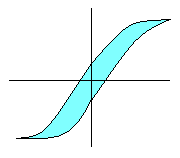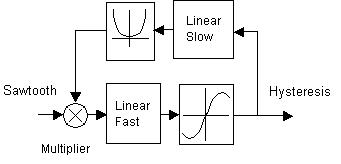
Proc. ISSS Third Canadian Conference, Ryerson, Toronto 1993
To propose a block diagram and a Volterra system solution to the general phenomenon of hysteresis.
Hysteresis is a phenomenon of energy consumption found in physics and animal behavior. There is a number of approaches to its modeling, such as simulation using step relays and spectrum division, nearly all are not analytical and do not lead to a mathematically rigorous representation. The phenomenon is nonlinear but simple to describe, it involves feedback yet cannot be modeled by a negative feedback loop. The background mathematics existed since the early 1900's but was avoided or not seen by engineers and zoologists, perhaps because of using complex integral equations. A re-examination led me to see how the mathematics under certain conditions works as the typical hysteresis phenomenon. The block diagram below is a continuous nonlinear system without switches or relays, when subjected to a sawtooth waveform the response follows the typical shape of hysteresis.

Fig. 1 Block diagram of Continuous Nonlinear System representation of typical hysteresis.
The block diagram can be re-stated as multi dimensional Laplace transfor expression and lead to a power series Volterra solution. However, the solution predicts only higher frequency harmonics, subharmonics, a known by-product of some but not all hysteresis phenomena, cannot be predicted by the Volterra solution.
